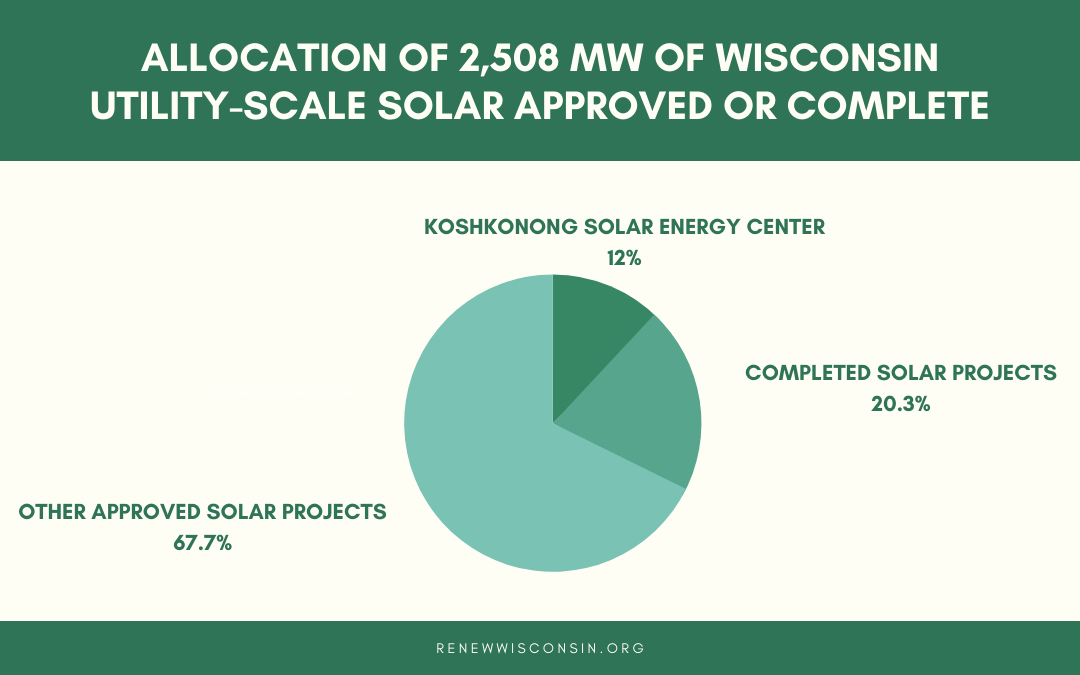
by Heather Allen | Apr 12, 2022 | Energy Storage, PSC Priorities, Public Service Commission, Solar, Utilities, Utility Scale
The Wisconsin Public Service Commission (PSC) approved the construction of the 300-megawatt (MW) Koshkonong Solar Energy Center in early April.
Developed by Chicago-based Invenergy LLC, this solar project will provide enough emission-free electricity to power 60,000 Wisconsin homes. It will become one of Wisconsin’s largest renewable energy generators, representing 12% of Wisconsin utility-scale solar projects that have been completed or approved as of today.
The Koshkonong Solar Energy Center will be located in southeast Dane County. In addition to the 300 MW of solar power, the project will feature a 165 MW battery storage component to help bolster grid reliability. WEC Energy Group and Madison Gas and Electric intend to buy the plant for $649 million.
“This project accelerates the state’s and the region’s transition to clean energy,” said Heather Allen, Executive Director at RENEW Wisconsin. “With enough capacity to provide one-fourth of the local solar needed to meet Dane County’s Climate Action Plan, Koshkonong’s approval is a major milestone in the transition to energy independence for the region.”
When energized, the project will generate $1.2 million per year in new revenue for local governments, in addition to lease payments to local landowners. Construction is expected to begin later this year and will likely become operational in 2025.
“The energy storage component of the project will provide up to 660 megawatt-hours of energy storage per day, or approximately the equivalent battery storage capacity of 6,000 electric vehicles,” Allen added. “Battery energy storage adds more flexibility to the project, allowing for energy use when it is needed most.”
Koshkonong is the fourth solar generation project proposed by Invenergy to receive construction approval from Wisconsin regulators and the third to be combined with an energy storage component. The four solar projects developed by Invenergy—Badger Hollow, Paris, Darien, and now Koshkonong—will comprise 1,050 MW of generating capacity when completed. The energy storage facility at Koshkonong will be the largest of its kind in Wisconsin.
In a separate proceeding, WEC Energy Group and Madison Gas and Electric seek permission to add the Koshkonong Solar Energy Center to their growing portfolio of renewable generating plants. The PSC will likely rule on this application before the end of this year.
In the technical hearing leading up to the PSC’s decision, RENEW provided expert testimony documenting the public benefits to be delivered by the Koshkonong solar and storage project. These benefits include:
- Displacing fossil generation with a zero-carbon source of electricity over its 30-year+ lifetime;
- Providing firm capacity at a Dane County location for replacing the 1,100 MW Columbia coal-fired power plant scheduled for retirement in 2024; and
- Supporting Wisconsin’s farm economy through lease payments to participating landowners and new revenues to local governments hosting the project.
Wisconsin currently has over 510 MW of completed utility-scale solar projects with nearly 2000 MW more approved. This upward trajectory of utility-scale solar projects will help Wisconsin meet its 100% carbon-free goals.
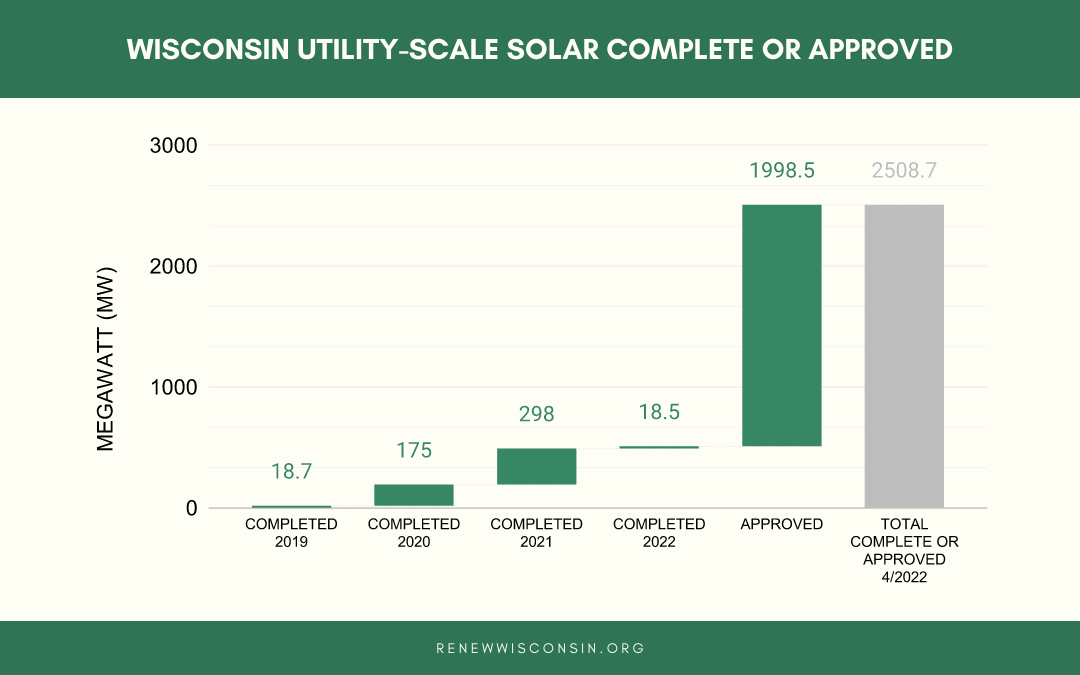
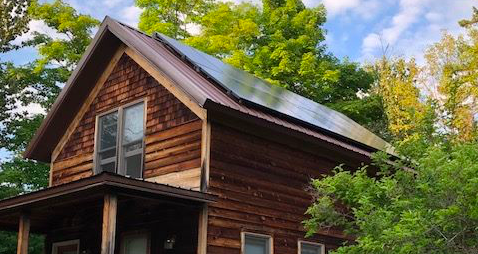
by Heather Allen | Mar 25, 2022 | Advocacy, Net Metering, PSC Priorities, Solar
RENEW Wisconsin, together with a coalition of Clean Energy Advocates (Clean Wisconsin, Environmental Law, and Policy Center, Vote Solar, The Nature Conservancy, Wisconsin Conservation Voters, and the Wisconsin Health Professionals for Climate Action), submitted comments this week to the Public Service Commission in favor of protecting and improving net metering in Wisconsin.
The Commission asked for remarks on four key questions and shared a 60-page memo from the Regulatory Assistance Project describing net metering policy issues, changes to net metering in other states, and several other aspects for consideration. The comment period closed on Tuesday, March 22, 2022.
Wisconsin’s customer-owned solar market is falling behind our neighboring states due to a patchwork of service terms and artificial market barriers. Our coalition comments highlighted several key factors contributing to the issue:
- The absence of a statewide net energy billing policy has fostered an inconsistent and confusing patchwork of tariffs across Wisconsin.

2. Low net energy billing ceilings and low export rates effectively exclude many larger customers from investing in solar systems.
3. Encroachment of utility-owned DG reduces behind-the-meter installation opportunities for customers and solar contractors.
4. The lack of clarity over third-party financing hampers the solar marketplace.
Solar installers, solar customers, clean energy advocates, and climate activists submitted comments echoing these themes. Here are some quotes from the commenters:
“The time has come for the Wisconsin Public Service Commission (WiPSC) to take a customer-centric approach to address the need for dramatic greenhouse gas emission reductions.”
Kerry Beheler and Gary Radloff
Wisconsin GreenFire
“Larger commercial and industrial customers should be allowed to net meter on larger projects that help them displace a greater percentage of their usage with on-site renewable generation. Adjacent states have raised net meter limits above 1000 kW for these customers. State goals of increased renewable energy are efficiently met with an on-site generation that is offsetting load, and this also possibly reduces the need for additional transmission infrastructure. Net metering is one good tool encouraging on-site renewable generation.”
Weselley Slaymaker
“I support a robust net metering policy for Wisconsin. The adaptation of solar power is critical for our energy independence and to mitigate the impact of climate change.”
Megan Stansil
RENEW and its allies explained their priority to improve net metering in the near term to “make net billing tariffs more consistent across Wisconsin utilities.” But we also urged caution that no other reform that could diminish customers’ value proposition for investing in these grid-beneficial technologies should be pursued before reaching much higher solar penetration levels and analyzing the impact of such potential changes.
Net metering is a valuable tool that helps customers generate their energy in a manner that provides both system and public benefits, including carbon emission reduction and economic development. It drives solar deployment and is easily understood and accessible to customers. RENEW will continue to participate in this conversation at the Commission and share results as this process moves forward. Wisconsin can improve customer transparency with a more uniform statewide approach but should be very cautious about risking the benefits of distributed generation by altering rate design.
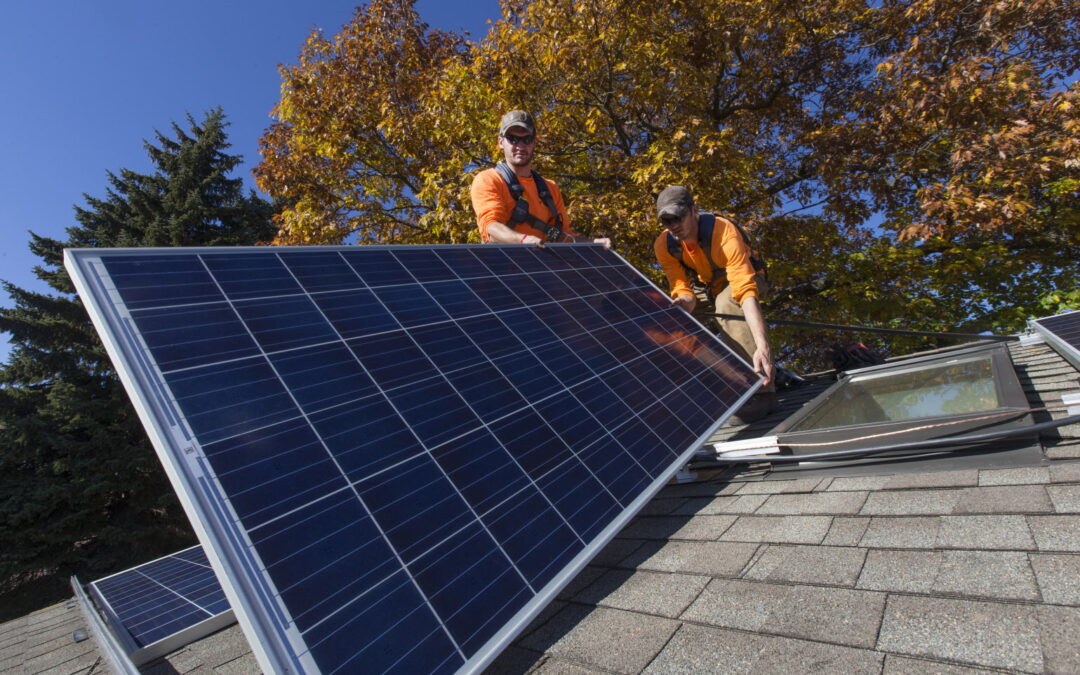
by Sam Dunaiski | Mar 24, 2022 | Local Initiatives, Renewables, Solar, Utilities
On Tuesday, March 22, 2022, the City of Madison and RENEW Wisconsin announced the 2022 MadiSUN residential solar group buy program. MadiSUN is for Madison-area homeowners looking to install solar-electric systems.
In its seventh year, the program offers Dane County homeowners easy access to qualified solar contractors at a competitive price. MadiSUN has spurred approximately $3.5 million in solar energy investments since 2016 and has added over 1,000 kilowatts of renewable electricity to the local electric grid. Over 200 homes in the Madison area have installed solar through the program.
“The MadiSUN program helps make it easy for residents to select an installer and get a cost-effective and high-quality solar system for their home,” said Stacie Reece, Sustainability Program Coordinator for the City of Madison. “Each additional rooftop installation gets us closer to our goal of 100% renewable energy for the City.”
Two local solar installation firms, Arch Solar and Full Spectrum Solar won a competitive bidding process and will design and install arrays for MadiSUN participants. Many solar design firms across Wisconsin anticipate a busy year for installations as Federal Investment Tax Credits begin to wind down in 2023.
“With tax credits at 26%, and utility rates increasing across the state, 2022 is a great year to go solar,” said Stanley Minnick, Head of Sales at Arch Solar, one of the participating contractors for MadiSUN. “This will likely be a record-setting year for residential solar.”
MadiSUN also provides homeowners with multiple options for financing. Loans are available through greenpenny bank and the Clean Energy Credit Union. However, homeowners may choose any financing mechanism they prefer, including home equity lines of credit or loans from other banks.
“Residents of Dane County can count on greenpenny for fast, easy, and affordable financing for their solar projects,” said Jason MacDuff, President of greenpenny. “Our team works hard to find a loan term within our residential solar program that allows for the borrower to trade their current electric bill for a solar financing payment.
In addition to financing and access to local solar contractors, MadiSUN participants have access to additional education sessions, which help them understand the benefits of at-home solar energy.
“Modern solar electric systems are still relatively new technology to many Wisconsin homeowners,” stated Sam Dunaiski, Distributed Resources Director for RENEW Wisconsin and administrator of the MadiSUN program. “The main goal of MadiSUN is to make going solar easy and affordable for any Madison area resident. We want to make sure everyone in the community understands how beneficial solar energy can be.”
Residents can receive a complimentary solar assessment by visiting madisunsolar.com and filling out the “I’m Interested” form. Applications for the Group Buy program must be submitted by August 31, 2022.
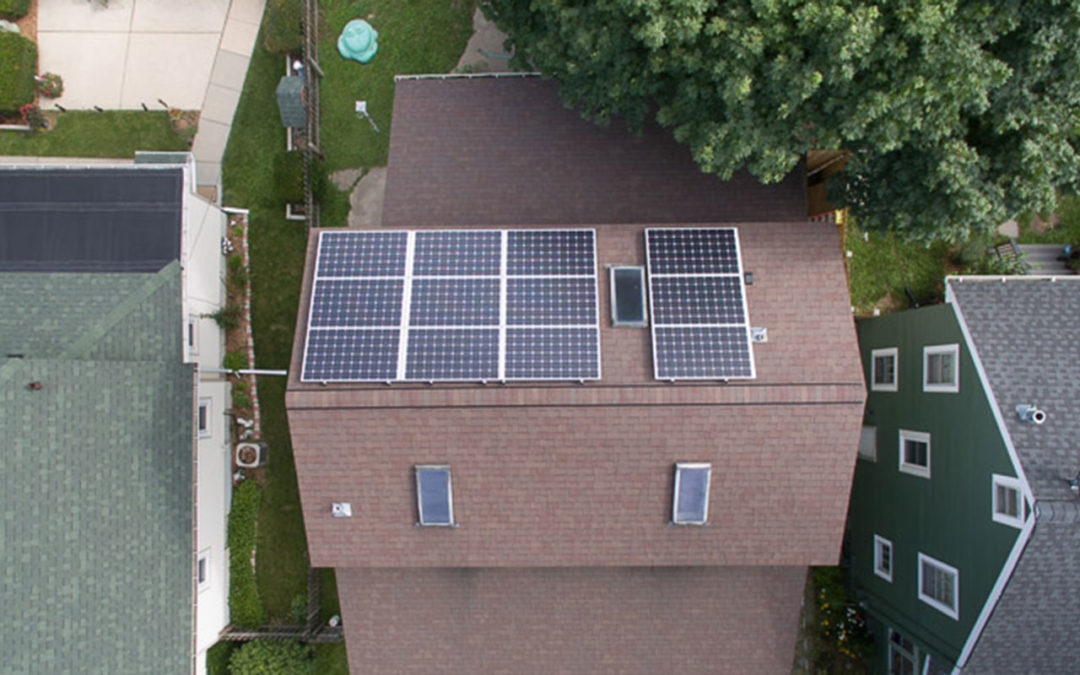
by Andrew Kell | Mar 18, 2022 | Advocacy, Policy, PSC Priorities, Public Service Commission, Solar
In June of 2020, the Public Service Commission of Wisconsin (PSC) opened an investigation into parallel generation (docket 5-EI-157). Parallel generation refers to distributed generation (DG) that is sited at a customer’s premises and can 1) produce energy for the customer’s energy use, and 2) produce and sell to the utility energy that exceeds the customer’s use. The most common type of DG is a solar photovoltaic (PV) rooftop system.
According to the PSC Notice of Investigation, this ongoing parallel generation investigation aims to gather information on costs, markets, emerging technologies, and barriers to DG in the state. A January 2021 RENEW blog described the initial activities in the docket.
After gathering information, the PSC made an initial decision in the docket to further explore:
- avoided costs and buyback rates for DG;
- net metering;
- contracts; and
- consistent terminology and terms of service across the state.
To better understand the value of DG, the PSC directed the five largest investor-owned utilities in Wisconsin to provide modeling and calculations of ‘avoided costs’ and revise the rates at which the utilities purchase energy from DG (also called ‘buyback rates’).
The utility’s buyback rate is a critical economic variable for DG. When homeowners and businesses entertain the idea of solar generation on their rooftops, they must first consider the costs and benefits of installation. The principal economic benefits of installing solar are reducing the energy you buy from the utility and getting paid for the excess energy you sell to the utility. Outside of the net energy billing services available for small installations, most utilities in Wisconsin pay very little for the energy they purchase from DG customers. Utility payments to DG customers don’t recognize the value of local, clean energy, which then oppresses the development of DG and hinders the advancement of carbon reduction goals.
It became apparent that upcoming PSC decisions would reset buyback rates and influence the business case for DG in Wisconsin, potentially for decades to come. As a result, RENEW put together a plan to participate in the utility cases and contracted with GridLab and Synapse Energy Economics to provide expert testimony on the issues.
When the utilities filed their buyback rate applications in early September last year, there were no major surprises to the clean energy community. Rather than model and calculate the long-term avoided costs of local, renewable DG, as the Commission requested, utilities either cited short-term marginal prices for some costs or simply stated that DG provides no value for other costs. RENEW needed to do more than simply critique the utility applications. The RENEW team developed a complete counterproposal for the Commission’s consideration, premised on criteria established by the Commission and just, reasonable buyback rates for DG customers.
Over several months, RENEW collaborated with its consultants and Keyes & Fox, a firm dedicated to clean energy law. Focusing on the Commission’s conceptual framework of avoided energy, generating capacity, and transmission costs, RENEW’s team gathered information, developed and ran market models, and calculated buyback rates. This ensured that RENEW’s proposal would meet the Commission’s requirements and recognize the actual value renewable DG provides to all utility customers.
These efforts resulted in a comprehensive framework for the Commission to consider and adopt for all utilities across Wisconsin. The RENEW team is now submitting testimony and evidence to support this comprehensive framework in all five utility cases.
RENEW now needs your support! The Commission will soon open the public comment period for these five cases and needs to hear from clean energy organizations, climate activists, businesses, and residents across Wisconsin. Below is a list of the five utility cases. RENEW will update the list with dates and direct links to make public comments when the public comment period becomes known. Since Commission decisions in these cases will set a precedent for all utilities in Wisconsin, we encourage you to comment on all 5 cases.
Click on applicable links below to submit comments for each utility.
Energy Policy Nerd Alert!
If you are interested in reading through the details of RENEW’s testimony filings, below are links to direct testimony filings for the case proceeding first (Xcel Energy, aka Northern States Power Company-Wisconsin). Testimony for other cases mentioned above will be available at a later date.
Direct Testimony of Andrew Kell
Direct Testimony of Michael Vickerman
Direct Testimony of Divita Bhandari (Synapse consultant)
Direct Testimony of Rachel Wilson (Synapse consultant)
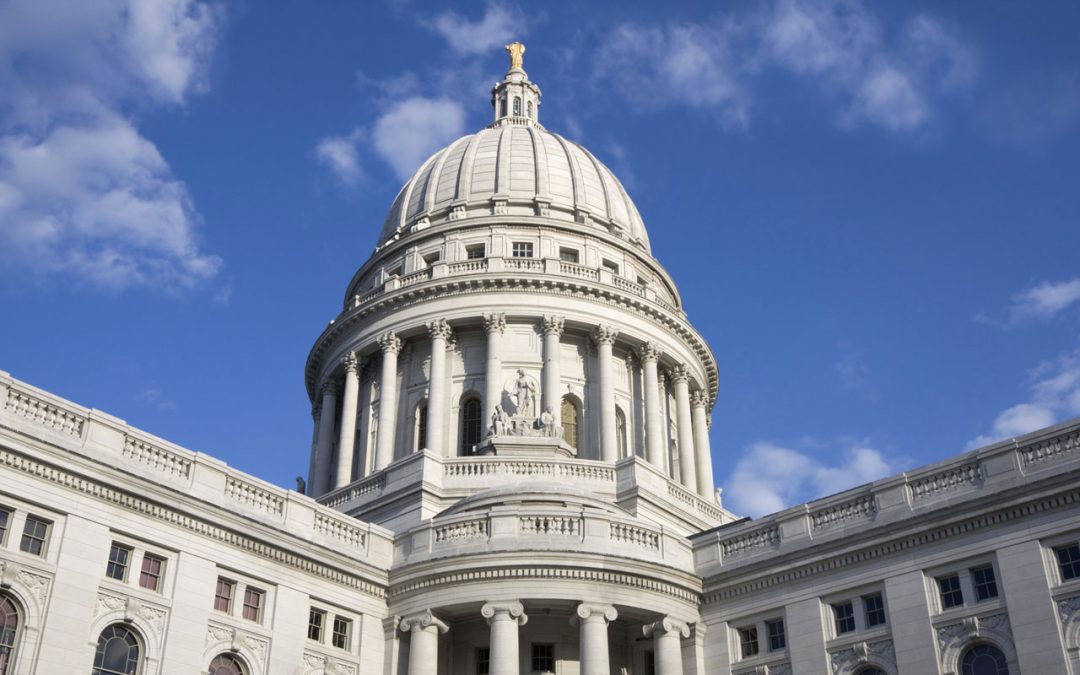
by Jim Boullion | Mar 18, 2022 | Advocacy, Community Solar, Electric Vehicles, Energy Storage, Legislative Watchlist, Local Government, Policy, Solar
The 2021-22 legislative session in Wisconsin is now over. It was a busy session for clean energy initiatives with legislation introduced to allow more community solar, clarify the rules for leasing solar equipment, and update the regulations for electric vehicle (EV) chargers. Most of these bills were bipartisan, with support on both sides of the aisle. See the bottom of this article for a summary of this year’s major clean energy legislation.
The session started when Governor Tony Evers introduced his 2021-23 Budget Bill in February 2021. It included 28 provisions (many of them drawn from the Governor’s Taskforce on Climate Change) that would have advanced Wisconsin’s clean energy and energy efficiency. Among those provisions were recommendations to expand Focus on Energy, invest in the clean energy workforce, and support Wisconsin’s electric vehicle infrastructure. Unfortunately, by the time the Governor signed the Budget in July, those provisions were removed from the Budget and did not pass.
On November 15, several Democratic legislators introduced a package of 22 bills called Forward on Climate. The package proposed increased funding for Focus on Energy, on-bill financing of energy efficiency improvements from utilities, and a Wisconsin Climate Corp to provide training and opportunities in clean energy industries for Wisconsin’s youth. The session ended without any of these bills being adopted. Still, it outlined what kinds of initiatives they support to create good, family-supporting jobs, reduce inequality, and fight climate change through Wisconsin-centered policies.
What passed and what progress was made?
The only major clean energy bill that passed this session was a bill to modernize the PACE financing program. However, many clean energy initiatives made in-roads with legislators from both sides of the aisle. The new technology developments and dropping prices for renewable energy over the last few years is an excellent story for reducing emissions, bolstering economic growth, diminishing energy prices, and creating jobs. Even if there are still hurdles to overcome, everyone is interested in learning more.
There is growing interest among a wide range of stakeholders in clean energy legislation. The best example is SB 490, the community solar bill, where many diverse interests have registered in support. While some groups have expressed concerns with the bill, most business and public interest groups who registered support this kind of change.
Even though we didn’t pass them this session, electric vehicle legislation is also getting attention, especially in light of the volatile gas prices this year. As the price of EV battery production falls, the initial price of EVs will get more competitive, making the cost of EV operations compared to petroleum-powered vehicles very attractive.
The EV transition is coming fast, and we need to be ready. We need to finalize the rules and regulations over EV charging, determine how to pay for the roads if the gas tax generates less income, and streamline the buying process for new EVs coming into the market. One of the big things happening in the coming year is the millions in federal Infrastructure Investment and Jobs Act money coming to Wisconsin for EV infrastructure. We need to work with all stakeholders to ensure that Wisconsin can utilize that money efficiently.
What happens next?
Over the summer and fall, RENEW Wisconsin will meet with candidates running for state and federal office. We will be educating them about new developments in clean energy and electric vehicles and discussing essential policy changes we need to make these advances available to everyone in Wisconsin.
You can also do your part by getting involved in your local elections, talking to your local candidates, and supporting the candidates who support clean energy with your votes, time, and financial contributions. This time of year, candidates are especially interested in what you have to say and will take the time to listen. Clean energy can have a big year in 2023, but only if we do the work this year to educate and help elect candidates who will support us!
If you would like information on any clean energy issues or the elections, please contact Jim Boullion, Director of Government Affairs, jim@renewwisconsin.org,
2021-22 Wisconsin Legislative Session
Clean Energy and Electric Vehicle Issue Summary
PACE Financing Modernization – (SB 692/Wisconsin Act 175 – Sen. Cowles and Rep. Thiesfeldt)
- Expands type of projects that may be financed: Adds energy reliability improvements, weather-related resiliency projects, electric vehicle charging infrastructure, and stormwater control measures.
- Financing: Defines the term of the repayment period, clarifies that financing may be repaid through a lien, and ensures that mortgage holders provide written consent before the issuance of funding.
- Performance Requirements: Removes the requirement for project savings to exceed project costs and would instead require a third-party assessment of the anticipated energy and water cost savings from the proposed project and confirmation of proper installation after work is completed.
- Excludes Residential PACE: Prohibits PACE financing for residential units of less than five units. PACE loans will remain only for commercial or industrial buildings.
Assembly: Passed on voice vote (2/23/2022) and sent to Governor for signature.
Senate: Passed 32-0 on 2/15/22.
RENEW Position: Support.
EV Charging Rules – (SB 573 – Sen. Cowles and Rep. VanderMeer) Clarify that selling electricity by the kilowatt-hour to electric vehicles (EVs) does not subject EV charging station owners to utility regulation. No city, village, town, county, school district, special purpose district, or state agency may own, operate, manage, lease or control a charging facility. Local governments can authorize a utility or private entity to operate a charger on their property. Requires that all energy come from the local utility, limiting Solar+Storage EV charger availability.
Senate: Passed on vote of 19-13 (2/15/2022). Did not concur with Assembly Amended bill 3/8/22
Assembly: Passed on voice vote, with amendment, (2/24/22). Failed to pass.
RENEW Position: Oppose due to restrictions on non-utility energy sources and restrictions on the State and local governments from owning or operating EV chargers.
Expanded Development of Community Solar – (SB 490 / AB 527 – Sen. Stroebel and Rep. Ramthun) Would authorize the development of non-utility-owned community solar projects, allowing more individuals and businesses to access clean energy, save money and create good-paying jobs. Require local investor-owned utilities (Cooperative and municipal utility territories would be exempt) to provide credits on utility bills of subscribers for the energy generated by the system. Directs the PSC to develop rules that will establish fair credit rates and compensation to utilities for the use of utility infrastructure and billing.
Assembly: Energy and Utilities. Failed to pass.
Senate: Utilities, Technology, and Telecommunications. Failed to pass.
RENEW Position: Support
3rd Party Financing/Leasing – (SB 702 / AB 731– Sen. Cowles and Rep. Cabral-Guevara) Clarify that 3rd party financing/leasing of renewable energy equipment is legal in Wisconsin.
Assembly: Energy and Utilities. Failed to pass.
Senate: Utilities, Technology, and Telecommunications. Failed to pass.
RENEW Position: Support
Energy Storage Sales Tax Exemption – (SB 672 /AB 710 – Sen. Cowles and Rep. Duchow) Clarify that battery storage devices installed as part of a renewable energy system should be included in the sales tax exemption for renewable energy system equipment.
Assembly: Committee on Ways and Means. Failed to pass.
Senate: Committee on Financial Institutions and Revenue. Failed to pass.
RENEW Position: Support
Use $10 million of VW Settlement Funds for EV Charging Station Grants – (SB 663/AB 695 – Sen. Cowles and Rep. VanderMeer) Grants from these funds will be used to install electric vehicle charging stations at key locations throughout Wisconsin. Requires the PSC and DOT to study how the growing number of EVs will impact the transportation fund and determine methods to ensure they contribute to that fund equitably. Grant recipients can only resell electricity obtained from the local electric utility. $5m for EV Corridors; $3m for businesses or multifamily; $2m to be determined by PSC.
Senate: Committee on Transportation and Local Government. Passed committee 5-0. Failed to pass.
Assembly: Committee on Energy and Utilities. Failed to pass.
RENEW Position: Support
Direct Purchase of Electric Vehicles – (SB 462 / AB 439 – Sen. Kooyenga and Rep. Neylon) Would enable electric vehicle manufacturers to deliver and service vehicles in Wisconsin using online sales or manufacturer-owned dealerships without going through a 3rd party dealership.
Senate: Senate Gov. Operations Committee. Passed Committee 4-1. Failed to pass.
Assembly: Committee on Transportation. Failed to pass.
RENEW Position: Support
Create a System to Measure Carbon Emissions for Animal Agriculture Operators. (SB1054 / AB 1072 – Sen. Cowles and Rep. Tauchen).
- DATCP shall establish voluntary and market-driven standards for quantifying the carbon emissions produced directly and indirectly from an animal agriculture operator’s activity.
- DATCP must facilitate trade in products and services related to transactions between animal agriculture operators and other parties for carbon emission offsets and may operate an electronic marketplace for selling and purchasing carbon emission offsets.
- PSC shall develop a statewide master plan for collecting, transporting, and commercializing renewable natural gas produced from animal wastes, biomass, and other organic sources.
- PSC will establish standardized power purchase agreements and standardized agreements for the provision of energy as a service between animal agriculture operators and electric utilities
Assembly: Committee on Energy and Utilities. Failed to pass.
Senate: Committee on Natural Resources and Energy. Failed to pass.
RENEW Position: Support
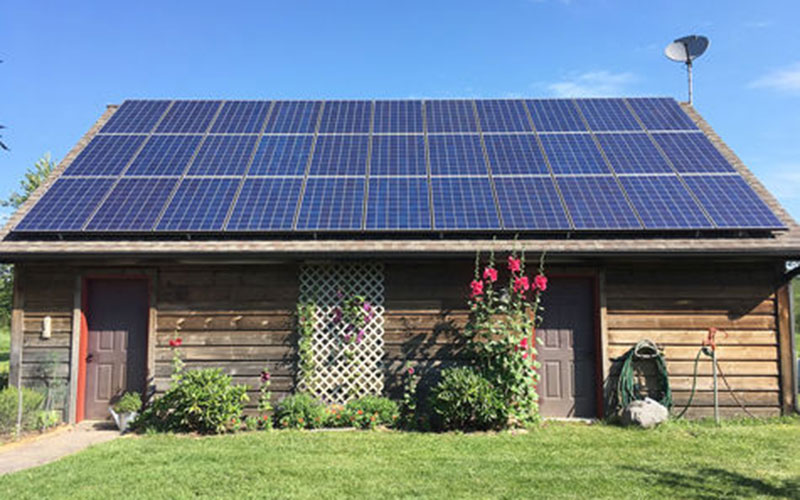
by RENEW Wisconsin | Mar 16, 2022 | Action Alert, Advocacy, Legislative Watchlist, Net Metering, PSC Priorities, Solar
Net metering is a billing policy that enables customers who generate electricity from solar energy to receive a bill credit for the excess energy they add to the grid. This arrangement allows residential and business customers to generate their own electricity, reduce carbon emissions, and provide substantial economic benefits to their communities.
In Wisconsin, net metering varies widely by utility. For example, some utilities use a monthly billing period for netting, while others use an annual period. Some utilities cap systems to 20 kilowatts (kW) for net metering purposes, while others have a 100 kW or 300 kW cap. Due to statewide inconsistencies across utilities, there are opportunities for policy improvements to provide clarity and better reflect the value of solar.
Solar customers and clean energy supporters have an opportunity to submit comments to the Public Service Commission in favor of protecting and improving net metering in Wisconsin. The Commission has asked for remarks on four key questions and shared a 60-page memo from the Regulatory Assistance Project describing net metering policy issues, changes to net metering in other states, and several other aspects for consideration. Comments must be received by 5:00 p.m. on Tuesday, March 22, 2022.
The PSC’s net metering questions (paraphrased):
- Do current net metering tariffs appropriately balance the ratemaking principles?
- Do current net metering tariffs align with the Commission’s mission and state energy policy goals?
- How could net metering tariffs better align with ratemaking principles and policy goals?
- What, if any, further action should the Commission take to review and reform net metering tariffs?
While RENEW is enthusiastic that the Commission is exploring ways to improve net metering, nuances in the memo could undercut rather than accelerate solar growth in Wisconsin. It is critical that any effort to rework net metering in Wisconsin protects the positive features of the current system and carefully evaluates the risks and benefits of any changes. As evidenced by the PSC’s 2021 PV potential study, Wisconsin can expand customer-owned solar, especially with the correct net metering policies. However, opening up the door to changes too quickly may put the current benefits of net metering at risk.
We encourage you to submit comments and share what’s working, what’s not, and why supporting a robust net metering policy is critical for Wisconsin’s clean energy future.
Thank you for your support!








